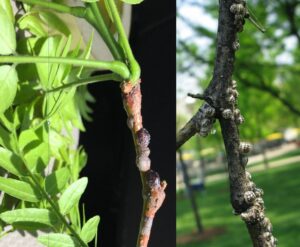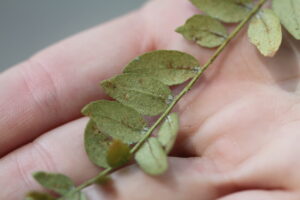Trees need to be tough to survive the abuse we put them through in cities. Often planted parking lots and on streets, they are stressed by drought in the summer and de-icing salts in the winter. Honeylocust trees are a great choice for cities because in addition to their pleasing shape and fall color, they are remarkably tolerant to salt. Moreover, their thin canopy allows grass to grow and simplifies the cleanup of leaves in the fall. Despite these attributes, these trees are highly susceptible to a wide range of insect pests. Tree health and appearance can be maintained through careful planning and attentive management.
- Honeylocust trees have a fine leaf texture that lets in enough light for turfgrass to flourish beneath their canopy.
- Honeylocust plant bug injury on honeylocust.
Managing Honeylocust Pests.

Mimosa webworm on honeylocust.
Active in May and June honeylocust plant bugs (HLPG) can distort and disfigure young, expanding leaves when they suck on leaf tissue. Although these insects can be found every year, they rarely cause enough damage to significantly thin tree canopies. As such, control is rarely needed. This is fortunate because effective products like foliar pyrethroids (bifenthrin, permethrin etc) and soil applied neonicotinoids (imidacloprid, dinotefuran) will kill beneficial insects that other pests under control.
With two generations a year (June, August), the mimosa webworm caterpillars will fold leaves and cover the canopy with brown, unsightly webs. Wandering caterpillars dangling on silk strands in late summer can be a nuisance on city streets. Defoliation can weaken the tree but is unlikely to kill it. Focus management efforts on the first generation to reduce the number present in the second generation. If few webs are present and within reach, it is possible to prune out injury. When webs are too numerous or out of reach insecticide may be needed to avoid unsightly injury. Foliar applications require the services of a professional with spray equipment that can reach the canopy. See the reference at the end of the article for a list of biorational products that can be used to protect trees without killing beneficial insects. In sites where foliar sprays are not possible, trees can be protected with injections of emamectin benzoate or soil applications of acephate.
Soft scale insects can threaten the health of honeylocust trees when they suck out plant sap and excrete copius amounts of liquid excrement (aka honeydew) on branches, leaves, and creating a sticky mess the ground below. When the honeydew gets covered with black sooty mold, the tree and the cars parked beneath them appear to be covered in soot. Water stress and heat generated by paved surfaces make trees in parking lots and streets especially susceptible to these pests. Control these pests by applying a foliar spray of an insect growth regulator, like pyriproxyfen, when the insects are in the crawling stage in late May. See the reference on scale insects at the end of the article for details.
- Calico (right) and European fruit lecanium (left) scales are common problems on honeylocust.
- Honeylocust spider mites can be a problem later in the summer on honeylocust.
Spider mites are not insects, but in the absence of predators can cause enough damage to defoliate trees in mid-summer. Mites live and feed on leaves by piercing leaf tissue and lapping up the liquid that bubbles up from the wounds. With multiple generations, they can grow from an egg to an egg laying female in about a week during the heat of the summer. Early season applications of broad-spectrum insecticides, like the neonicotinoids (imidacloprid, Spinosad) and pyrethroids often set the stage for mite problems. Although miticides are to reduce mite populations available (See reference at end of article), it is best to avoid the problem by using the tips described to reduce pesticide use against scale insects, mimosa webworms and honeylocust plant bugs.
Finally, when possible, avoid over planting honeylocust trees by planting them in small groups rather than lining entire streets. In this way, it is more difficult for pests to infest and spread between trees.
For more information:
See PurduePlantDoctor.Com and,
Mimosa Webworm https://extension.entm.purdue.edu/publications/E-11/E-11.html
Spider Mites on Ornamentals: https://extension.entm.purdue.edu/publications/E-42/E-42.html
Scale Insects How to Fix Problems with Scale Insects – Purdue Landscape Report.



